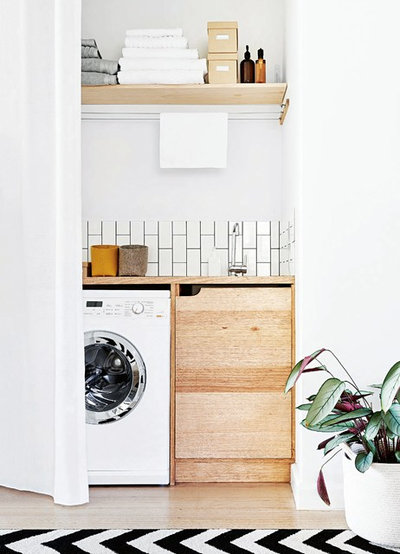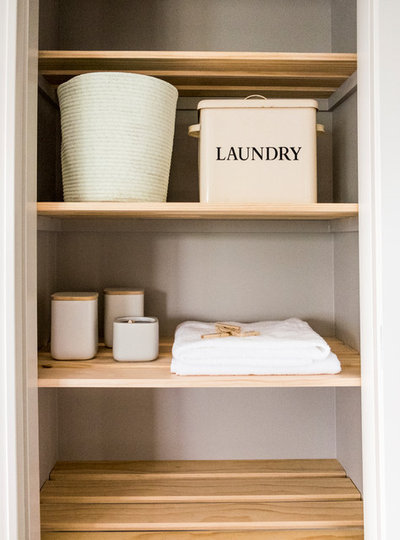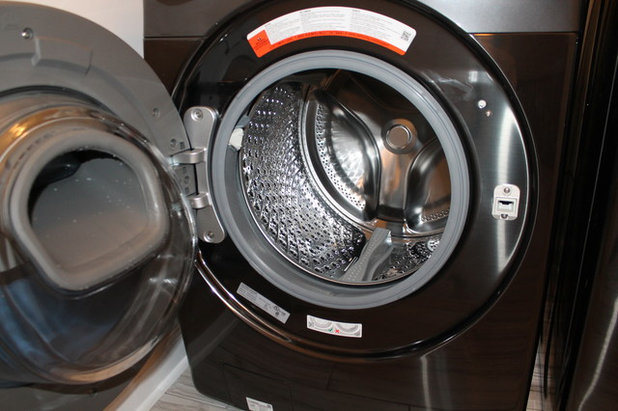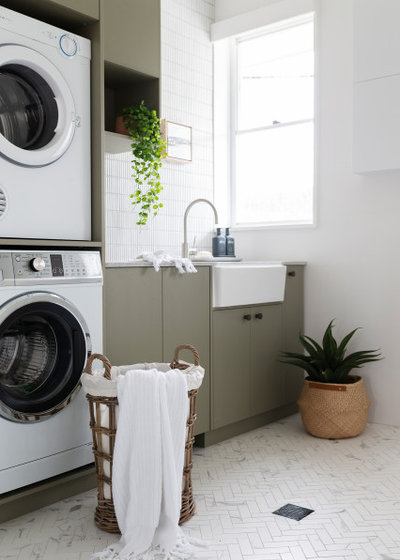How to Clean Your Washing Machine (Yes, You Really Should)
Cleaning your washing machine once a month will ensure it stays spick and span... along with your clothes
Marianne Lipanovich
20 April 2022
Houzz Contributor. I'm a California-based writer and editor. While most of my projects are garden-based, you might also find me writing about home projects and classical music. Away from the computer, I'm found in the garden (naturally), on my bike, or ice-skating outdoors (yes, that is possible in California). I'm also willing to taste-test anything that's chocolate.
Houzz Contributor. I'm a California-based writer and editor. While most of my projects... More
Just because you fill it with laundry detergent doesn’t mean you don’t need to clean the washing machine itself. It sounds counterintuitive, but while your machine is ridding your clothes of dirt, it doesn’t always rid itself of that same dirt or a build-up of detergent residue.
In addition, the newer high-efficiency machines can be especially prone to developing mould and mildew, especially if you live in an area with high humidity levels, which can lead to an odour developing both in the machine itself and on your ‘clean’ clothes. “We take our washing machines for granted,” says Taryn Brucia, a public relations director at LG Electronics. “They do some dirty jobs. We should give them some love.” With that in mind, here’s how to clean a washing machine.
How often should you clean a washing machine?
Most manufacturers recommend cleaning your washing machine once a month, although a quick internet search and survey of friends and family will confirm that the majority of us are still wrapping our heads around the idea of cleaning our machines.
Others, though, clean theirs even more often. “I have a separate cleaning cycle as an option on my washing machine and run that cycle after I wash cleaning rags every week,” says Becky Rapinchuk of Clean Mama. Fortunately, the process is fairly painless, especially because the machine itself does most of the work.
Prefer to outsource cleaning to a professional? Find a cleaner near you on Houzz who can do it for you
Most manufacturers recommend cleaning your washing machine once a month, although a quick internet search and survey of friends and family will confirm that the majority of us are still wrapping our heads around the idea of cleaning our machines.
Others, though, clean theirs even more often. “I have a separate cleaning cycle as an option on my washing machine and run that cycle after I wash cleaning rags every week,” says Becky Rapinchuk of Clean Mama. Fortunately, the process is fairly painless, especially because the machine itself does most of the work.
Prefer to outsource cleaning to a professional? Find a cleaner near you on Houzz who can do it for you
Before cleaning: identify your machine and select your cleanser
The type of washing machine you have will dictate which method you use to clean it. High-efficiency front loaders and top loaders need one approach, while traditional top-loading machines need a slightly different approach.
Before you start, decide what type of cleanser you want to use: white vinegar, bleach or a commercial cleanser. Using vinegar to clean a washing machine is non-toxic and it’s readily available, making it a favourite for both Brucia and Rapinchuk, but some manufacturers recommend bleach or other chemical cleaners, so check the manual for your machine. If you are using a commercial product, follow the label’s instructions for the recommended amount.
Tip: Choose only one cleaner. You never want to mix these products.
The type of washing machine you have will dictate which method you use to clean it. High-efficiency front loaders and top loaders need one approach, while traditional top-loading machines need a slightly different approach.
Before you start, decide what type of cleanser you want to use: white vinegar, bleach or a commercial cleanser. Using vinegar to clean a washing machine is non-toxic and it’s readily available, making it a favourite for both Brucia and Rapinchuk, but some manufacturers recommend bleach or other chemical cleaners, so check the manual for your machine. If you are using a commercial product, follow the label’s instructions for the recommended amount.
Tip: Choose only one cleaner. You never want to mix these products.
How to clean a high-efficiency washing machine (front loader or top loader)
A monthly cleaning is especially important if your high-efficiency machine has developed an odour. “Wiping down the interior of the washer with cleaner, using extra detergent or running everything on the longest, hottest cycle does nothing to help dissipate the scent,” says Rapinchuk, adding that doing this cleaning task will eliminate the odour and keep your washing machine “in tip-top condition”.
Many newer high-efficiency machines have a clean cycle, which makes the process even simpler, but the basic procedure is the same whether you have that function or not:
A monthly cleaning is especially important if your high-efficiency machine has developed an odour. “Wiping down the interior of the washer with cleaner, using extra detergent or running everything on the longest, hottest cycle does nothing to help dissipate the scent,” says Rapinchuk, adding that doing this cleaning task will eliminate the odour and keep your washing machine “in tip-top condition”.
Many newer high-efficiency machines have a clean cycle, which makes the process even simpler, but the basic procedure is the same whether you have that function or not:
1. Choose the ‘clean’ cycle. If your machine doesn’t have this, select the hottest water setting. In some cases, this may be the setting for whites or heavily stained clothes.
2. Choose the added rinse cycle if it’s available.
3. Fill the bleach dispenser with the cleanser of your choice.
4. Fill the washing-machine drum to the highest water level (this will probably be automatic with the clean cycle) and run the machine.
5. If you don’t have a second rinse cycle, run the rinse cycle again manually.
2. Choose the added rinse cycle if it’s available.
3. Fill the bleach dispenser with the cleanser of your choice.
4. Fill the washing-machine drum to the highest water level (this will probably be automatic with the clean cycle) and run the machine.
5. If you don’t have a second rinse cycle, run the rinse cycle again manually.
Once the cycle has ended, use a microfibre cloth dipped in vinegar to clean the gasket that seals the door and the area around it. “Carefully pull it back and inspect to see if you have mould, mildew or socks (as is the case with mine) underneath,” says Rapinchuk.
Don’t overlook cleaning the washing machine soap dispensers. Use vinegar or soapy water to wipe any detergent, bleach, fabric softeners or other laundry add-ins from the dispensers. “You can often just pop them out,” says Brucia. Wipe off all these areas with a cloth dipped in water and dry them with a microfibre cloth.
Finish by wiping down the controls and the outside of the machine with a microfibre cloth dipped in vinegar or an all-purpose cleaning spray. To make the exterior shine, dry it with a microfibre cloth.
Don’t overlook cleaning the washing machine soap dispensers. Use vinegar or soapy water to wipe any detergent, bleach, fabric softeners or other laundry add-ins from the dispensers. “You can often just pop them out,” says Brucia. Wipe off all these areas with a cloth dipped in water and dry them with a microfibre cloth.
Finish by wiping down the controls and the outside of the machine with a microfibre cloth dipped in vinegar or an all-purpose cleaning spray. To make the exterior shine, dry it with a microfibre cloth.
How to clean a top-loading washing machine
Although older top loaders don’t generally have a cycle for cleaning, you can easily create your own version. It involves a bit of a wait time between beginning the cycle and ending it, so use that time to clean other areas that won’t be reached by the water in the tub:
1. Choose the hot water setting and the longest cycle.
2. Fill the tub to the maximum level, then pause the machine.
3. Add four cups of white vinegar or one cup of bleach to the water and let the machine agitate for a minute or two.
Although older top loaders don’t generally have a cycle for cleaning, you can easily create your own version. It involves a bit of a wait time between beginning the cycle and ending it, so use that time to clean other areas that won’t be reached by the water in the tub:
1. Choose the hot water setting and the longest cycle.
2. Fill the tub to the maximum level, then pause the machine.
3. Add four cups of white vinegar or one cup of bleach to the water and let the machine agitate for a minute or two.
4. Pause the washing machine and let it sit for an hour. Dip a microfibre cloth into the soaking solution, wring it out and use it to clean the top of the drum and agitator (where the water doesn’t reach) as well as the inside of the lid.
If you can remove the bleach and fabric-softener dispensers, do so and clean the areas beneath them with the cloth and cleaning solution. If they are fixed in place, clean them and the area around them. Brucia says that using vinegar to clean a washing machine will help eliminate detergent build-up.
Finally, clean the control panel and the outside of the machine with the cleaning solution or an all-purpose spray. Use a dry microfibre cloth to dry and polish the surfaces.
If you can remove the bleach and fabric-softener dispensers, do so and clean the areas beneath them with the cloth and cleaning solution. If they are fixed in place, clean them and the area around them. Brucia says that using vinegar to clean a washing machine will help eliminate detergent build-up.
Finally, clean the control panel and the outside of the machine with the cleaning solution or an all-purpose spray. Use a dry microfibre cloth to dry and polish the surfaces.
5. Restart the machine and finish the cycle. “You won’t smell the vinegar, but if you do, simply add another rinse cycle,” says Rapinchuk.
Browse more beautiful laundries by Australian designers
Browse more beautiful laundries by Australian designers
Daily (or almost daily) care
The experts also have some advice for preventing a build-up of dirt and odours between cleanings. If mould and mildew are a problem, leave the machine’s door or lid open after you finish a load of laundry so the interior dries out completely. Before you do this, make sure curious children and pets can’t get into the machine, especially if it’s a front-loading one. Some machines have latches designed to keep the door ajar without leaving it wide open.
Brucia also recommends wiping down the door or lid to get rid of any condensation. Wiping and drying the gasket around the door every time you finish a load of laundry will help prevent a build-up of dirt in that area. As a final tip, be sure to use the correct amount of detergent for your loads.
The experts also have some advice for preventing a build-up of dirt and odours between cleanings. If mould and mildew are a problem, leave the machine’s door or lid open after you finish a load of laundry so the interior dries out completely. Before you do this, make sure curious children and pets can’t get into the machine, especially if it’s a front-loading one. Some machines have latches designed to keep the door ajar without leaving it wide open.
Brucia also recommends wiping down the door or lid to get rid of any condensation. Wiping and drying the gasket around the door every time you finish a load of laundry will help prevent a build-up of dirt in that area. As a final tip, be sure to use the correct amount of detergent for your loads.
Your turn
Do you clean your washing machine? Tell us how in the Comments below, like this story, save the images, and join the conversation.
More
Wondering what else in your home needs cleaning? Find out here with Unsung Spring-Cleaning Jobs You May Not Have Thought Of
Do you clean your washing machine? Tell us how in the Comments below, like this story, save the images, and join the conversation.
More
Wondering what else in your home needs cleaning? Find out here with Unsung Spring-Cleaning Jobs You May Not Have Thought Of
Related Stories
Renovating Advice
How Do I Find, Assess & Hire the Right People for My Renovation?
Do you need a kitchen designer or a joiner? An architect or an interior designer? Find out with our essential reno guide
Full Story
Renovation Guides
What Key Measurements & Room Dimensions Should I Know for a Reno?
Read practical information about key room measurements and minimum clearances for fittings and fixtures in every room
Full Story
Bedrooms
12 Decorating Tips to Make Any Bedroom Look Better
By Anne Ellard
Want to know how to make your bedroom look better? Here are 12 great tricks
Full Story
Renovation Guides
Room by Room: Experts on Ways to Avoid Common Renovation Blunders
From the kitchen to the garden, and all areas in between, experts identify common mistakes and share priceless insights
Full Story
Bathroom Expert Advice
5 Reasons Your Bathroom Smells Funky (and How to Fix the Problem)
A plumber reveals five reasons your bathroom might smell like sewage or emanate a musty odour
Full Story
Kitchen Renovations
From Planning to Pendants: Kitchen Lighting Essentials
By Joanna Tovia
This valuable guide will give you all you need to know about choosing kitchen lighting for fabulous form and function
Full Story
Living Rooms
The Full Picture: How High Should Your TV Be?
By Matt Clawson
We look at an important question to consider when locating your television: how high should you set it?
Full Story
Bathrooms
All the Dimensions You Need to Know for Your Bathroom Makeover
Fit everything comfortably in a small or medium-size bathroom by knowing standard dimensions for fixtures and clearances
Full Story
Renovation Guides
How to Control the Cost of Your Renovation, Room by Room
Where to save, where to spend (and all the tricks in between) for keeping the cost of your renovation on track
Full Story
Architecture
Renovation Insight: How to Choose an Architect
A great architect can turn your dream home into reality – three industry experts reveal where to look for the right one
Full Story




































Based on a previous comment, I add Borax to most loads and find that my front loader stays fairly clean. I also clean once a month with bleach. I have a reminder for the first Sunday of every month to clean the dishwasher, clothes washer, jetted bathtub and cat fountains. Now that I have a schedule going, it bothers me to break it.
Never had an issue with the first generation of front load washer. My Kenmore Elite in 2003 never had an issue. Fast forward Kenmore Elite 2013 horrible. Have to keep everything opened when done. Door and dispenser. Can’t do laundry during the night as clothing would sit too long. Everything has to be removed immediately when washed and placed in dryer. I don’t know the difference. I am thinking the front seals have changed. Lot of places where water settles. I tried vinegar, hot water, and the specialized washing machine cleaner was the only thing that worked. Now if I remove immediately and open the door and dispenser, it stays nice.
I feel that we are leaving out an important step in this. My front loader has a filter and water reservoir on the bottom (usually has a small panel on the front of the washer) which needs to be emptied and cleaned as well. The filter grabs anything such as hair, pet hair and other things from the load along with draining out the water reservoir. Check your manual for this!! This is KEY to having a completely clean and odor free washer. If it’s never been emptied, be prepared for stinky water and possibly a lot of it. I usually use the clean cycle once a month and then drain the machine of all excess water and clean the filter. I love the other recommendations about vinegar - I use this in all other places!!